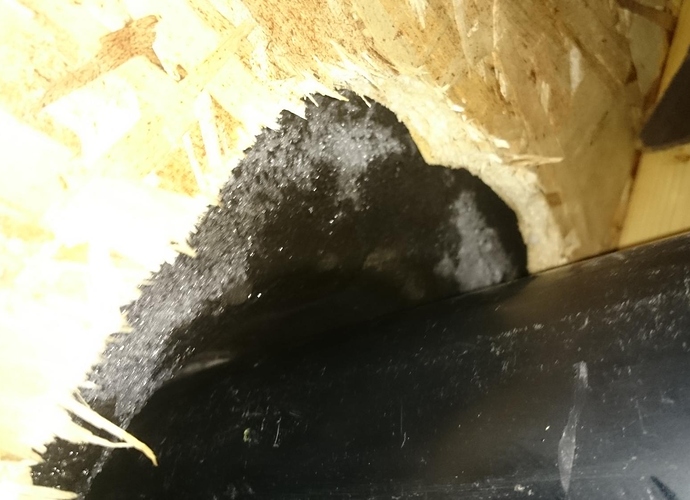What may be the cause of frost in the attic? Heat loss from interior? Poor ventilation? Both?
Warm moist air from the home . Needs better sealing .
How much insulation is there .
Lack of proper insulation most likely.
Both. I often find frost in attics with lots of insulation, especially homes that have added insulation, and blocked the eaves. Poorly insulated attics are nice and warm, so no frost.
Why do people relate insulation to keeping things from freezing?
Probably should be thinking vapor barrier or ventilation, more than insulation, or lack of.
It should be very cold in the attic. Frost is from moisture, which should not be in the attic.
What perceives me is putting in a vapor barrier and not sealing electrical and plumbing holes / routes etc. from the basement and at each floor. :roll:
What I describe to my clients as a “nullified Vapor Barrier”.
I tell my client’s it’s like chlorinating 1/2 of your swimming pool! ![]()
Nachi needs a “like button” for the best answer …haha
It happens when too much heat escapes into the attic due to a lack of insulation and/or possibly an additional heat source like a pellet or wood stove that throws additional heat into the home, which escapes rapidly into the attic. Bathroom and kitchen fans along with dryers can sometimes be found venting in the attic as well. Warm, moist air goes to cold (sheathing) and raises the moisture content of the wood, which freezes as the structure cools or is cold. The sheathing moisture levels rise over 20% for an extended period of time and microbial activity can thrive. The dry lumber standard for me in the Northeast is 9-12 percent. This happens when a home cannot exhaust the heat fast enough and high enough (warm air rises). Multiple forms of venting are necessary so that incoming air can effectively and efficiently push the air out and sit down over the insulation (cold air drops). The attic temps should be very close to the outdoor temps in the cooler months. A ridge vent and soffit vents are great. But if you get a lot of snow, the ridge vent can get blocked by ice (as heat is getting out and icing up) and snow and not work properly. The finer mesh ridge vents block with blown in over time as well. Having Gable vents in this case, will help. It is a wives tale that you cannot or should not have all 3. You need a minimum of 1 ft.2 for every 300 ft.2 of floor space in the attic. The maximum (and what I prefer) is 1 ft.2 to 150 ft.2. Insulation in my neck of the woods (Vermont) should be at least R49. I love R 60. Soffits should be clear and have proper vents installed. All ceiling penetrations should be air sealed with no appliances venting into the attic. No vapor barriers between the ceiling and insulation or anywhere on the attic floor (at least not in a cold climate). You will create secondary damage and mold on the ceilings as the moisture will become trapped and eventually destroy the ceilings as it moves backwards. We rip them down all of the time for that reason. Set bathroom fans on timers for full house air exchanges throughout the day and you will have comfortable shack.
I agree with others, it is lack of roof ventilation, insulation, or disconnected bathroom exhaust vent, etc.
It may cause of poor ventilation. If circulation of air is not done well than it causes the frost of attic. So give proper ventilation in your particular area.
Ventilation should always be the third, not the first, weapon in your arsenal. If ventilation channels are improved without any attempt to perform air sealing work, ventilation improvements may make the problem worse or increase a home’s fuel bills. Adding more venting can depressurize an attic, pulling warm air through the inadequate insulation and unsealed openings in the ceiling, bringing more heat than ever against the roof sheathing.
For sure
I’ve come across an attic with a localized moisture build up spot. In troubleshooting the stain on ceiling two floors below I traced it up along the plumbing vent pipe to the roof as likely travel path for water coming down. Near the vent pipe in attick I noted staining on roof truss and about a foot away the insulation was about 6-12" less in a 1’ circle than the rest of the attic (blown in insulation over batting in all of attic, but blown in missing here). Possible that refilling in this void in insulation will cure the centralized condensation issue? Note client said stain appeared right after weather warmed from -35 C to -15C. Roof still covered in snow. No staining on sheething, but frost build up noted around underside of the seal around plumbing vent through sheething.
Moisture from the home into the attic and lack of adequate ventilation.
Dry heat loss won’t do it.
Frost forms from moisture not dry air.
Some morons just don’t understand the moisture thingy.
Moisture escape is pretty much a given is it not? Pretty much impossible to have a perfect seal, especially in areas where you have penetrations like plumbing stacks.
When one grasps warm air holds more moisture than cold air the rest is common sense.
Things including molecules expand when heated and can hold more water vapor… Follow me? When it hits cold the molecules contact and it is like wringing a sponge. Any big time experts disagree?

